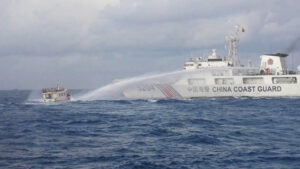By Kenneth Christiane L. Basilio, Reporter
THE PHILIPPINES and India held their first joint naval exercises in the disputed South China Sea, Philippine military officials said on Monday, just as President Ferdinand R. Marcos, Jr. left for a state visit to New Delhi.
The two-day sea drills began on Sunday and have been “productive so far,” according to Armed Forces of the Philippines (AFP) Chief-of-Staff General Romeo S. Brawner, Jr.
Philippine and Indian forces have met their “objectives for the exercise,” he said in mixed English and Filipino, based on a video shared with reporters.
“We are hoping that these would continue because we still have many exercises and activities with the Indian Armed Forces,” he added.
The naval exercise proceeded without incident, despite the presence of two Chinese warships in the area. “We didn’t experience anything untoward,” Mr. Brawner said. “There was shadowing, but we expected that already.”
Philippine Lieutenant Colonel John Paul C. Salgado said two vessels from the People’s Liberation Army-Navy were monitored near the area but did not interfere.
“The activity proceeded without interference… However, they were continuously monitored and tracked,” he said via Viber message.
The South China Sea remains a key regional flashpoint, with China asserting sweeping claims based on its so-called nine-dash line, overlapping with the exclusive economic zones of countries like the Philippines, Vietnam, and Malaysia.
A 2016 ruling by a United Nations-backed tribunal in The Hague voided Beijing’s claim, but China has rejected the decision and maintains significant naval presence in contested areas, including the Spratly Islands and Scarborough Shoal.
Clashes between Philippine and Chinese vessels have intensified in recent months, as Manila pushes back against what it calls repeated incursions into its waters.
In his pre-departure speech, Mr. Marcos expressed hope for closer ties with India, highlighting shared maritime interests and challenges.
“Our geostrategic position as coastal states that border the busiest international trade routes and critical sea lines of communication in the Indo-Pacific region… and our unwavering commitment to regional peace and cooperation serve as a credible foundation of our active and growing maritime cooperation,” he said, according to a transcript from the Presidential Communications Office.
Like the Philippines, India has been entangled in border disputes with China along the Himalayan region. The two nuclear-armed nations share about 4,000 kilometers of border, much of which is contested.
Manila has been pushing India’s inclusion in the Squad, an informal grouping of the US, Australia, Japan and the Philippines formed in 2024 to bolster regional maritime security and conduct joint patrols in the South China Sea.
The Philippines and the US earlier this month affirmed their commitment to boosting deterrence measures in the South China Sea amid China’s increasing assertiveness in the contested waterway.
Philippine National Security Adviser Eduardo M. Año said he had met with US Secretary of State Marco Antonio Rubio in Washington, DC, where both sides discussed efforts to deepen their alliance and expand cooperation in defense and security.
The meeting came as both countries aim to counter increasingly aggressive Chinese activities in the region, including the deployment of China Coast Guard and maritime militia vessels near Philippine-occupied features.
The 1951 Mutual Defense Treaty obligates both nations to come to each other’s aid in case of an armed attack in the Pacific area, including the South China Sea.
Relations between the two countries have strengthened under Mr. Marcos, who has taken a more assertive stance against Beijing’s maritime claims.
The Marcos administration has expanded joint military exercises with US forces, opened additional sites under their Enhanced Defense Cooperation Agreement (EDCA) and pursued stronger ties with other Indo-Pacific partners.
